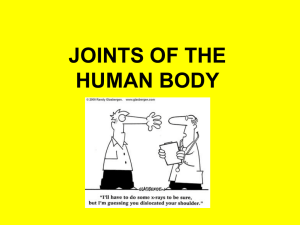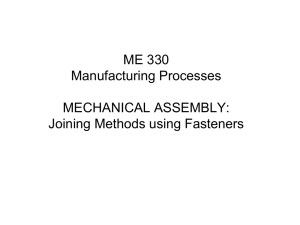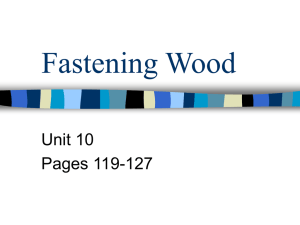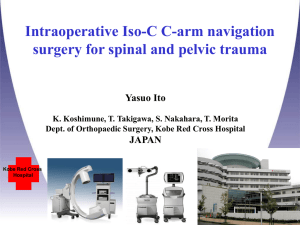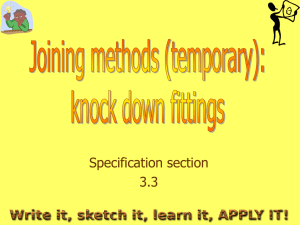Joining materials
advertisement
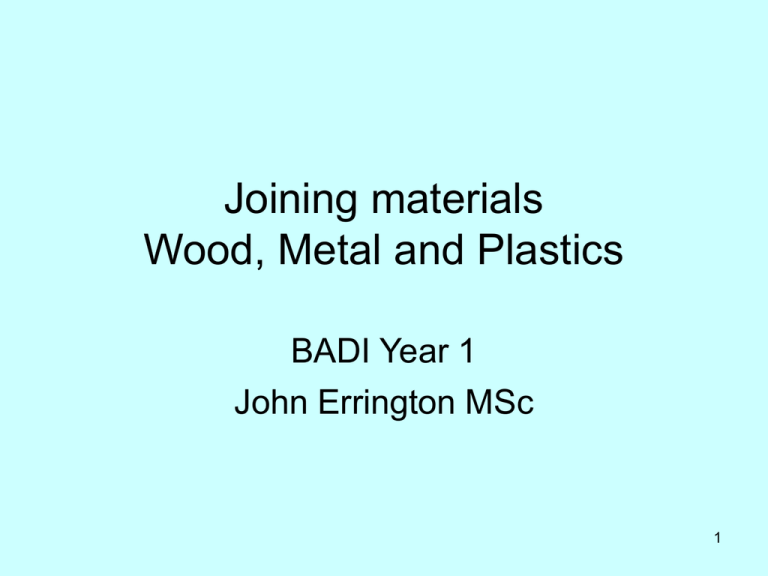
Joining materials Wood, Metal and Plastics BADI Year 1 John Errington MSc 1 Types of joint Most products are made from more than one piece of material, so when the product is assembled or fabricated the pieces need to be joined. Joints can be either permanent or temporary, and there are many different types. 2 Permanent and temporary joints Permanent joints are intended to stay put. They may make use of adhesives, nails, rivets, or one of the heat processes of brazing, soldering or welding. Assembly jigs are often used to hold components in place while they are being joined. For example, the parts of a steel roof frame can be put into the jig and then welded together. 3 Temporary Fixings These usually involve components with a screw thread, such as screws, nuts and bolts, or one of the many knock down fixings on the market. 4 Adhesives • There are many types of adhesives to suit different materials. When you are choosing the right one for your product you will have to take into consideration the type of material, the strength of the bond required and the environment the product will work in - for example if you are gluing timber for outdoor use, you would not use polyvinyl acetate (PVA), because it is water soluble. • Double-sided tape will join almost anything to anything. It is widely used in industry, for example, many parts of aircraft are held together with double-sided tape! 5 Joining wood 1: Screws, nails, glues and knock-downs There are many different ways of making joints in wood. The method used will depend on the function of the product, the strength required and the quality of the product. Temporary fixings will often be done using fastening components such screws or bolts. More permanent joints can be achieved with glue, or with nails - though these may lack strength and be rough-and-ready in appearance. 6 Screws All screwing needs two sizes of hole. The clearance hole must be very slightly bigger than the shank of the screw, so that the shank can move freely in the clearance hole. The pilot hole must be smaller - slightly smaller than the core of the screw - so that the core fits tightly into it. Clearance hole Pilot hole Because screws are tapered they will act as a wedge and often split the wood if a pilot hole is not used. 7 Types of screws Screws come with different types of head. They can be flat, countersunk or round-headed, and be fitted with a slot (for traditional screwdrivers), crosses (for Phillips or Pozidrive screwdrivers) or square holes (for square drivers). If the screw head is to lie flush with the surface of the material, the hole must be enlarged or countersunk. 8 Screw heads 9 Machine screws Machine screws are used for joining metal and plastic components. They fit into a tapped (threaded) hole in the material or are fixed with a nut and washer 10 Self-tappers Self-tapping screws are made from very hard steel. They have a thread which goes all the way up to the head, and cut an internal thread as they are screwed in. They can be used in metal and plastic as well as wood. If removed and reinserted they can damage the material they are fastening, and a bigger screw would be needed. 11 Self-drilling screws Made of hard steel they combine a drill and tap to make a proper thread in the material, and a screw to hold them together. If removed they can be replaced with care to pick up the thread properly. 12 Some different woodscrews • Traditional screws come in steel or brass and may be coated or passivated to prevent corrosion. They originally had a slot type head. • Modern ‘supascrews’ have a double helix and a sharp thread that cuts into the wood and is easier to screw in. 13 Nails Nails come in different shapes and sizes. Nails are much cheaper than screws and quick to put in. You do not need to drill holes in the wood first, except sometimes when using hard wood or to prevent the wood splitting. The nails shown above go straight into concrete! 14 Glues When using glue, make sure you: * Get the surfaces to be glued to fit well - no gaps! * Don't put any finish on the surfaces to be glued. * Make sure the surfaces are clean. * Get everything ready before you start - glue, brush, damp cloth, clamps and blocks to protect your work. * Don't start to glue up unless you are sure you have enough time you can't stop half way through! 15 Knock-down joints Much furniture is sold in flat packs. This makes it easy to transport and store. The customer then has to assemble it at home. Usually knockdown (KD) fittings are used. Most KD fittings consist of corner blocks or bloc-joint fittings. Usually these are made from a plastic such as nylon. 16 Joining wood 2: frame joints Strong, permanent and neat-looking joints in timber are achieved using one of the many types of frame joint - so called because right-angled jointed frames are common in furniture, boxes and many other types of assembly. 17 Simple frame joints The simplest frame joint is a butt joint. It is easy to make, but weak. You can strengthen a butt joint by fixing a reinforcing plate over the joint. A butt joint can also be strengthened by gluing dowel into both parts - making a dowelled joint. Dowelled joints are good for joining man-made boards (modified timbers) which might split easily if screwed or nailed. Corner halving joints are stronger than butt joints, as there is more contact for gluing, and the shoulder gives extra mechanical strength. Through housing joints are used for shelves. 18 More complex frame joints • Mortise and tenon joints, though more difficult to cut, are very strong, because of the shoulders. If your joint is close to the end of a piece of wood, use a haunched mortise and tenon joint. • Dovetail joints are very strong and look good - but are complex and difficult to cut. They are often used in high-quality furniture. • Comb or box joints are easier to make - especially by machine - and offer good contact for gluing. They are often used in wooden boxes. 19 Brazing and soldering • Brazing is a way of bonding materials (usually metals) by melting a filler metal or alloy between the components you want to join. The filler metals used in brazing usually have melting points between 450°C and 1000°C, but must have a lower melting point than the material being joined. Brazing forms very strong, permanent joints. • Soldering is a type of brazing which works at lower temperatures. Soft soldering is used to make permanent joints between copper, brass, tinplate or light steelwork, and is the normal way of joining electronic circuit components. Soft solder melts at about 200°C. The solder flows into the heated metal along the joint, distributes itself by capillary action, and grips the two pieces together when it all cools. Hard solder melts at 625°C, and is used for stronger joints. 20 Soldering and welding 21 Rivets • Rivets are components used for joining metal (and sometimes plastics and plywood). A hole is drilled through both pieces of work, the rivet placed through it, and its end beaten into a dome. A tool called a rivet set or rivet snap is used to finish the joint off neatly. Some rivets are countersunk. • With most rivets you need to get at both sides of the work to make the joint. Pop rivets enable you to complete the joint while only having access to one side of the work. They are usually used for joining thin sheets together. 22 Joining plastics Plastic products are often moulded so they just snap together. If you have to make a permanent joint, a specialist adhesive is often the best choice. Plastic adhesives: – Plastic weld is a multi-purpose plastic adhesive that joins most types of plastics (do not use it in on foamed plastics). – Tensol 12 is good for acrylic. It is quick and easy to use. But if spilt it marks the work. It is not very strong. – Tensol 70 is much stronger. It is acrylic based. It comes in two parts. It is not easy to use, as it takes 1.5 hours to harden and contracts. 23 Nutserts and blind fasteners Rivets, nuts, bolts and machine screws can also be used for joining plastics. However screws and bolts don’t work well in soft materials. One way of overcoming this problem is to use an insert such as a ‘nutsert’ – a metal insert with an internal thread ready for a machine screw to run into. These can be cast into plastics or inserted into a hole with a special tool. http://www.avdel.textron.com/ 24



